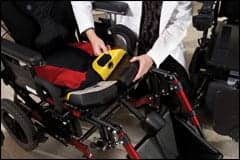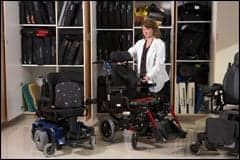 |
| Proper measurement, adjustment, and positioning of wheelchair cushions ultimately benefits the end user. |
Many individuals are seated in wheelchairs that are improperly fitted, and they frequently run the risk of developing skin compromise. Pressure sores are consistently and without question one of the most serious problems with regard to seating and positioning that a therapist will see on the job. At the Wheelchair Clinic at Good Shepherd Rehabilitation Network in Allentown, Pa, these individuals receive a comprehensive evaluation to ensure their wheelchair fits properly to avoid pressure sores and further medical complications.
Various studies indicate pressure sores affect millions of people each year, with many of these sores coming as a result of improperly fitted wheelchairs. Pressure sores are a medical issue, and they are most dangerous for those needing long-term care as a result of conditions such as spinal cord injuries. But they are also an avoidable issue when the correct course of action is taken.
DEFINING THE PROBLEM
Before trying to understand the various ways to prevent pressure sores for those restricted to a wheelchair, it is important to understand their cause, prevalence, and effect. By definition, pressure sores are areas of damaged skin and tissue that develop as a result of sustained pressure on various susceptible parts of the body. This pressure cuts off circulation, which impedes adequate blood flow to various parts of the body such as the lower back, buttocks, and shoulder blades—not to mention the backs of patients’ arms and legs. Without the proper blood flow, skin integrity is compromised and damaged, resulting in a pressure sore.
Just about anyone can get a pressure sore; however, it is those individuals who are prone to being in a certain position, such as lying in bed or sitting immobile, for extended periods of time who are at the greatest risk of developing a pressure sore. Several studies estimate that up to 80% of individuals with spinal cord injuries will have a pressure sore during their lifetime, while 30% will have more than one.
There are a number of factors that put people in wheelchairs at a higher risk for pressure sores. For those with spinal cord injuries, the most obvious risk is a lack of mobility, which does not allow patients to perform independent pressure relief. Any extended pressure on an area of the body can damage skin.
Even if the spinal cord injury is incomplete and there are varying degrees of mobility, severe sensory impairment to various or specific parts of the body remains a factor. This results in the patient failing to realize that their skin is being damaged as opposed to an able-bodied person who has the ability to shift weight constantly without ever being aware of it.
Another prevalent trouble spot is skin irritation caused by moisture as a result of bladder/bowel issues, which tends to weaken the skin and allows for an increased risk of skin cells breaking down.
The damage resulting from a pressure sore can range anywhere from irritation limited to the top layers of the skin, to the more serious problem of deteriorating soft tissue, leaving bones and joints vulnerable to infection. When the irritation is at an elevated level, the problems can lead to amputation, autonomic dysreflexia, or even death.
Patients with spinal cord injuries make up a large portion of those in wheelchairs who might need long-term care, and constitute the group that must be concerned with the possibility of pressure sores. Other individuals who need to be aware of the dangers of pressure sores are patients with multiple sclerosis, muscular dystrophy, and ALS and certain stroke patients. In all cases, properly fitting patients in their wheelchairs is a critical process that needs to be done correctly the first time.
AN OUNCE OF PREVENTION
Our ultimate goal as therapists is to have patients functioning as independently as possible, and this is realistic only when the wheelchair is a proper extension of each patient. There are two great ways for an able-bodied person to understand the feeling of an ill-fitted wheelchair. First, try walking 5 miles in a pair of shoes two sizes too small. The blisters that develop on your feet are a clear sign of impending pressure sores. Second, try sitting perfectly still at your desk for 10 minutes. The initial damage done to your body may be minor, but the results will make clear what is possible for the disabled, who might be forced into this position for multiple hours over the course of many days, weeks, months, and even years. In some cases, healing a pressure sore might just be a matter of changing the seat cushion. But too often, patients end up at a wound center, where the healing process can take weeks or even months. Often, if not treated quickly, the damage may be permanent.
 |
| Above: A therapist adjusts the air levels in the cells of a multicellular, air-filled design wheelchair cushion. |
The best way to avoid such issues is to ensure the initial wheelchair fitting is done correctly. It can be accomplished with relative ease as long as the patient is well educated and the therapist pays attention to detail.
A checklist for a proper fit should be prepared by looking at the patient from head to toe. The accessories that need to be considered include:
- a headrest, which must be at the appropriate height and provide the appropriate support;
- “back support from top to bottom;
- “pressure-relieving seat cushions necessary to help with continued blood flow to the lower back and buttocks;
- “trunk support, which might include a chest strap or lateral pieces;
- “leg support in the form of legrests and calf pads;
- “knee buttons, so the side of the knee does not rub against the metal portion of the wheelchair;
- “knee abductors, which separate the legs;
- “footplates, which need to be sufficiently soft and angled correctly.
Therapists can add a large number of accessories to the seating system, but the basic message is clear: Make sure the patient and the therapist choose the right positioning, the right pressure-relieving surface, and the optimal comfort level needed to accomplish a proper fitting.
The easiest way to make sure the wheelchair fitting is done right the first time is to have as many samples and seating components on site as possible. Constructing a complete mock-up allows a patient to actually test the wheelchair at the clinic. This allows therapists to see and educate the patient as to what will work and what possibly might need improvement.
MAPPING THE WAY
Technology has made it much easier for therapists to properly identify a wheelchair system for long-term care that greatly reduces the risk of pressure sores. At facilities like those at Good Shepherd, pressure-mapping systems are available to identify potential problems.
 |
| Amy Kirkner, MPT, ATP, below, is a staff therapist and coordinator of Good Shepherd Rehabilitation Network’s Wheelchair Clinic. |
The mapping system includes a thin mat that is placed on top of the wheelchair seat cushion and hooked up to a computer. The software allows therapists to see exactly how much pressure is being applied to various areas. This information not only gives therapists specific and concrete data regarding the proper pieces of equipment, but it also helps the patient to better understand where the vulnerable spots may be. The mapping system takes a lot of the guesswork out of the equation for the therapist, and it also creates an important sense of physical and emotional comfort for the patient.
PATIENTS HELPING PATIENTS
No matter how much prevention is used, patients need to educate themselves to identify pressure sores in their beginning stages.
Recently, a patient from a group home came to Good Shepherd needing help. He had a lightweight manual chair with just the basic accessories, and he was constantly experiencing thin pressure sores on his lower back. Physically, this patient was in a condition that would allow him to shift his weight, thus diminishing the chances of serious health problems. But cognitively, he was unable to process the need to do so, which did not allow him to get the repositioning and pressure relief he needed.
When we first met him, his chair was in disarray. His cushion was not adjusted appropriately, his folding chair wasn’t completely unfolded, and his legrests were at the incorrect height. He had the right equipment, but it was not being used properly. A few adjustments and repairs ensured that the patient experienced optimal pressure relief and comfort. In this case, the patient and caregiver were both reeducated as to how to properly maintain the wheelchair, ensuring the proper fit.
On the other hand, there are an equal number of patients who might know how to properly maintain the wheelchair, but don’t have the correct equipment. Often, the chairs are too tight, which squeezes the patient into an uncomfortable and dangerous position. In other cases, the chair is entirely too large, which leaves the patient shifting around into awkward positions.
In either case, these problems and their solutions are easily identified and can be corrected by making a quick trip to the wheelchair specialist.
FINAL CHALLENGE
As a therapist, the most challenging factors in providing the proper care to prevent pressure sores are proper medical coverage and funding. Convincing insurance companies to provide the correct equipment patients need to stave off the possibility of pressure sores is increasingly difficult, but it is a fight worth fighting.
 |
For patients with long-term therapeutic needs, the most pressing factor in keeping the body and skin healthy can be directly attributed to their ability to integrate fitted wheelchairs into their daily lifestyle—not just at home, but also at school, at work, with their transportation, and with their family.
Taking all of these factors into account will not guarantee a life free of pressure sores, especially for those suffering from spinal cord injuries. But if patients receive the proper education and have access to a strong support system that ensures they are fitted correctly into a wheelchair, there is an excellent chance for the prevention of pressure sores.
Amy Kirkner, MPT, ATP, is a staff therapist and wheelchair clinic coordinator, and Patti Dworak, MSOT, OTR/L, ATP, is a staff therapist at Good Shepherd Rehabilitation Network’s Wheelchair Clinic, Allentown, Pa. For more information, go to www.GoodShepherdRehab.org.





